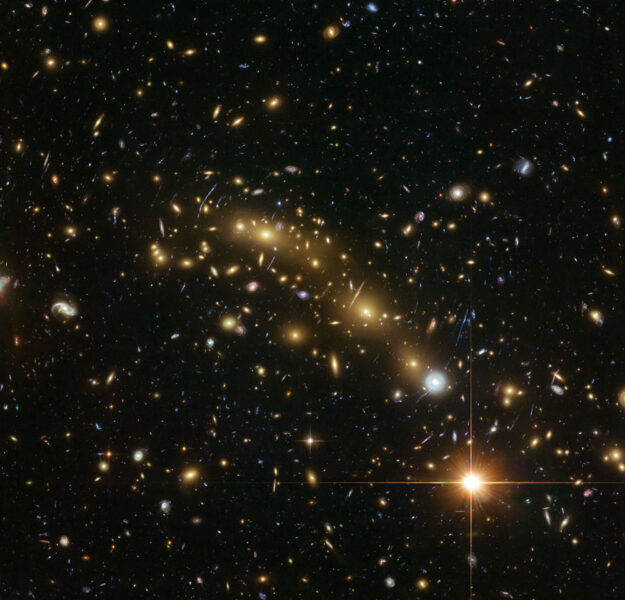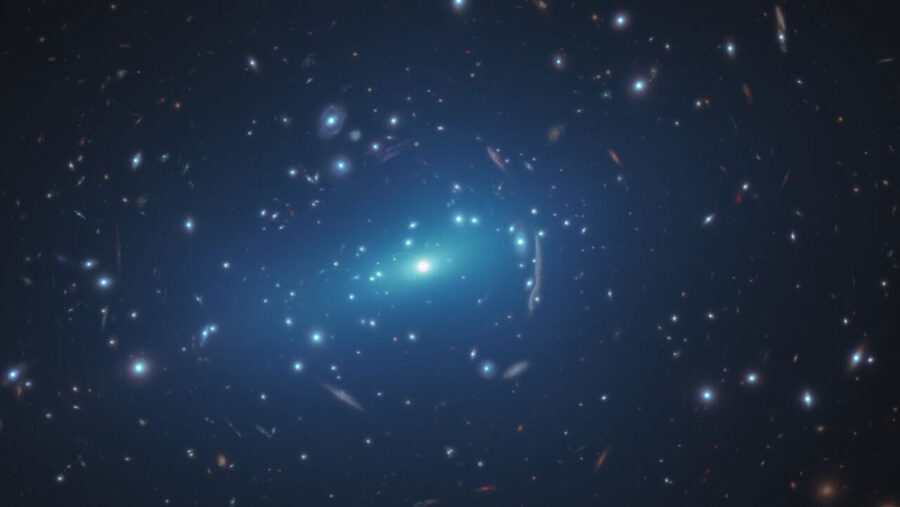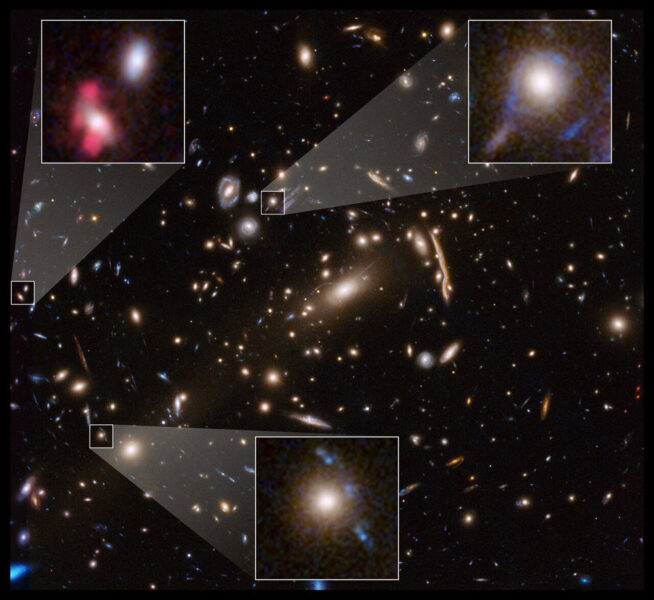Astronomers studying Hubble Space Telescope images of massive galaxy clusters have uncovered a potential problem with dark matter.

ESA / NASA / Hubble Space Telescope Frontier Fields
Acknowledgement: Mathilde Jauzac and Jean-Paul Kneib
Galaxy clusters are the largest gravitationally bound structures in the universe. They’re also the most massive, containing not only the stars and gas we see in hundreds of galaxies, but also the frustratingly invisible dark matter in and around them.
In the September 11th Science (paper available here), Massimo Meneghetti (National Institute of Astrophysics, Italy, and Caltech) and colleagues present a new way of visualizing the unseen dark matter in clusters. And the results appear to contradict what theorists would have expected.
Lumps in the Dough
Theorists have long known that dark matter isn’t smooth. Instead, like a botched baking project, the dark matter halos that surround galaxies — and galaxy clusters — have lumps, or as astronomers term them, subhalos.

ESA/Hubble, M. Kornmesser
Like kneaded dough, neither halo nor subhalos stay still. “[Subhalos] move on orbits around the cluster center, interacting with the larger halo they are embedded in, and occasionally colliding and merging with other subhalos,” Meneghetti explains.
Between the hundreds of galaxies in a cluster, there should be a lot of subhalos — simulations specify how many we might expect. Some of them could have stars and could even be faintly visible as dwarf galaxies. Others might be entirely dark. Most of them, in any case, would be difficult to observe.
Meneghetti’s team came up with a way around that. Because galaxy clusters are so massive, they act as gravitational magnifying glasses, lensing the light from background galaxies into arcs or multiple images. A galaxy cluster’s mass may create images separated by several tens of arcseconds, but a subhalo in just the right place in the cluster might create additional images separated by less than a few arcseconds.
The team used detailed images and data from the Hubble Space Telescope and the European Southern Observatory's Very Large Telescope in Chile to examine several galaxy clusters, counting up the number of those small-scale lenses that only subhalos can make. Then they looked at what cosmological simulations predict.

NASA / ESA / G. Caminha (Univ. of Groningen) / M. Meneghetti (Observatory of Astrophysics and Space Science of Bologna) / P. Natarajan (Yale) / CLASH team.
To the researchers’ astonishment, the simulations predict far fewer halos than were observed. And try as they might to explain the difference, there were no easy answers.
“To me personally, detecting a gnawing gap — a factor of 10 discrepancy in this case — between an observation and theoretical prediction is very exciting,” says team member Priyamvada Natarajan (Yale).
Frank van den Bosch (also at Yale), who was not involved in the study, calls the results “potentially groundbreaking.”
“The authors address all the ‘obvious’ candidates for what might explain this,” he says. “I agree with them that none of them seem to be able to reconcile the large discrepancy found.” He adds that the result is likely to spawn a number of follow-up studies that examine the abundance, structure, and other properties of dark matter lumps.
The Opposite of Missing Satellites
By coincidence, the dark matter “problem” that Meneghetti and colleagues have uncovered is the exact opposite of a decade-old, now-solved predicament known as the “missing satellite problem.”
Earlier on, cosmological simulations had modeled only the behavior of dark matter, as that’s what dominates the universe gravitationally. But those simulations predicted that galaxies like the Milky Way ought to have way more satellites. Even as telescopes improved and astronomers discovered additional, fainter dwarf galaxies, they weren’t enough to make up the difference. It wasn’t until simulations began taking regular ol’ matter into account — including all the bombastic effects of supernovae, jet-throwing black holes, and all the rest — that the predicted numbers began matching observations.
Now, though, astronomers have the opposite problem – there are too many subhalos instead of too few. But it’s also on an entirely different scale — galaxy clusters instead of galaxies, massive subhalos instead of minuscule ones.
“The missing satellites problem deals with the small-mass subhalos in galaxies,” Meneghetti says, “while here we are looking at the highest mass tail of the subhalo distribution.”
Still, the analogy suggests that this new “problem” might help us learn more about dark matter. “There are many issues related to galaxy formation and evolution in cluster environments in the context of other dark matter models that are yet unexplored,” Meneghetti says, “in particular regarding the interplay between ordinary and dark matter.”
For now, there’s more work to be done in extending the analysis to additional clusters, not to mention exploring other dark matter candidates. And in the years to come, the European Space Agency’s Euclid mission, the Vera C. Rubin Observatory, and NASA’s Nancy Grace Roman Space Telescope will offer the opportunity to probe the dark matter structure of galaxy clusters as never before. Says Meneghetti, “These observations will be a gold mine for us!”
 6
6









Comments
Howard
September 13, 2020 at 7:05 pm
I wonder what the cluster's inter-galactic magnetic field energy density would have to be to account for these observations?
You must be logged in to post a comment.
Andrew James
September 13, 2020 at 11:18 pm
No. Ain't strong enough (Regardless what PU/EU says.).
You must be logged in to post a comment.
Howard
September 14, 2020 at 9:03 pm
What are PU/EU?
You must be logged in to post a comment.
Andrew James
September 19, 2020 at 8:05 pm
Plasma Universe / Electric Unierse
You must be logged in to post a comment.
Robert-Casey
September 14, 2020 at 3:53 pm
A question about pictures of lensed galaxies behind the galaxy clusters doing the lensing. Why are the lensed objects blue? I would have thought that they, being much more distant, would be red shifted and look red.
You must be logged in to post a comment.
Yaron Sheffer
September 19, 2020 at 7:17 pm
The color you see depends on the redshift, as well as on the unshifted color of the source. For example, a young spiral galaxy with active star formation would be bright in the UV, which upon redshifting would become bright in optical blue, thus dominating over the reddening effect from the redshift. Also, the ratio of (intrinsically bluer) spirals to (intrinsically redder) ellipticals is increasing with distance.
You must be logged in to post a comment.
You must be logged in to post a comment.